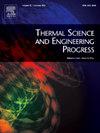Proposing wavy-shaped legs for performance improvement of thermoelectric generators: energy, exergy, environmental, and mechanical analysis using a CFD-trained machine learning method
IF 5.1
3区 工程技术
Q2 ENERGY & FUELS
引用次数: 0
Abstract
The innovative wavy-shaped leg proposed in this research enables a longer thermoelectric leg without increasing the total height of the thermoelectric module (see the graphical abstract). A greater leg height enhances TEG’s performance while maintaining the same overall module height. The proposed idea is investigated from energy, exergy, environmental, and mechanical performance perspectives using machine learning trained with data coming from a 3D validated numerical simulations based on the Finite Element Method (FEM) for a segmented thermoelectric generator. The wavy-shaped leg is designed with varying wave amplitude (Aw), number of cycles (N), leg thickness (tl), and height ratio between segments (hr), all of which are evaluated based on their impact on voltage, generated power, efficiency, exergy-based efficiency, CO2 savings, and von Mises stress. The FEM simulations are then used to develop a highly accurate predictive model employing Deep Neural Networks (DNN), enabling rapid and efficient optimization and extrapolation across parameter values. Comprehensive results are identified and reported in this study. According to the results, the wavy structure generates more power while the higher number of cycles the higher generated voltage. Outcomes also confirm that larger Aw, N, hr, and values yield considerable improvements in terms of thermoelectric performance. For instance, at = 35,000 W/m2 and hr = 0.8, output power reaches 0.0178 W, with respective CO2 savings of 0.03045 kg. Slim legs (tl = 0.1) in combination with larger Aw values maximize output and efficiency but drive von Mises stress over 400 MPa. The DNN model accurately forecasts such trends, with high agreement with FEM (e.g., for Aw = 0.1 mm and tl = 0.1 mm) DNN forecasts CO2 savings of 0.01893 kg, in contrast with 0.01888 kg for FEM). It also yields continuous and smooth extrapolation for intermediate values, such as hr = 0.24032 (voltage = 0.076676 V) and tl = 0.1201 mm (stress = 270.02 MPa). Integration between FEM simulations and prediction with DNN brings computational accuracy and efficiency together, allowing for rapid and efficient optimization of robust and high-performance TEGs.
提出用于热电发电机性能改进的波浪形腿:使用cfd训练的机器学习方法进行能源,火用,环境和机械分析
本研究中提出的创新的波浪形腿可以在不增加热电模块总高度的情况下实现更长的热电腿(见图形摘要)。更大的腿高可以提高TEG的性能,同时保持相同的整体模块高度。本文从能源、火用、环境和机械性能的角度对所提出的想法进行了研究,使用机器学习训练的数据来自基于有限元法(FEM)的分段热电发电机的3D验证数值模拟。波浪型支腿设计具有不同的波幅(Aw)、循环次数(N)、支腿厚度(tl)和段间高度比(hr),所有这些都是根据它们对电压、发电量、效率、基于㶲的效率、二氧化碳减排和冯米塞斯应力的影响来评估的。然后使用FEM模拟开发采用深度神经网络(DNN)的高精度预测模型,实现快速有效的优化和跨参数值的外推。本研究确定并报告了综合结果。结果表明,波浪结构产生的功率越大,循环次数越多,产生的电压越高。结果还证实,较大的Aw、N、hr和qin值在热电性能方面产生了相当大的改善。以atqin = 35000 W/m2, hr = 0.8为例,输出功率达到0.0178 W,分别减少0.03045 kg的二氧化碳排放。细长的腿(tl = 0.1)与较大的Aw值相结合,最大限度地提高了输出和效率,但驱动冯米塞斯应力超过400mpa。DNN模型准确地预测了这种趋势,与FEM(例如,对于Aw = 0.1 mm和tl = 0.1 mm)高度一致,DNN预测二氧化碳减少0.01893 kg,而FEM预测为0.01888 kg)。它还可以对中间值进行连续和平滑的外推,例如hr = 0.24032(电压= 0.076676 V)和tl = 0.1201 mm(应力= 270.02 MPa)。FEM模拟和DNN预测之间的集成将计算精度和效率结合在一起,允许快速有效地优化鲁棒和高性能teg。
本文章由计算机程序翻译,如有差异,请以英文原文为准。
求助全文
约1分钟内获得全文
求助全文
来源期刊

Thermal Science and Engineering Progress
Chemical Engineering-Fluid Flow and Transfer Processes
CiteScore
7.20
自引率
10.40%
发文量
327
审稿时长
41 days
期刊介绍:
Thermal Science and Engineering Progress (TSEP) publishes original, high-quality research articles that span activities ranging from fundamental scientific research and discussion of the more controversial thermodynamic theories, to developments in thermal engineering that are in many instances examples of the way scientists and engineers are addressing the challenges facing a growing population – smart cities and global warming – maximising thermodynamic efficiencies and minimising all heat losses. It is intended that these will be of current relevance and interest to industry, academia and other practitioners. It is evident that many specialised journals in thermal and, to some extent, in fluid disciplines tend to focus on topics that can be classified as fundamental in nature, or are ‘applied’ and near-market. Thermal Science and Engineering Progress will bridge the gap between these two areas, allowing authors to make an easy choice, should they or a journal editor feel that their papers are ‘out of scope’ when considering other journals. The range of topics covered by Thermal Science and Engineering Progress addresses the rapid rate of development being made in thermal transfer processes as they affect traditional fields, and important growth in the topical research areas of aerospace, thermal biological and medical systems, electronics and nano-technologies, renewable energy systems, food production (including agriculture), and the need to minimise man-made thermal impacts on climate change. Review articles on appropriate topics for TSEP are encouraged, although until TSEP is fully established, these will be limited in number. Before submitting such articles, please contact one of the Editors, or a member of the Editorial Advisory Board with an outline of your proposal and your expertise in the area of your review.
 求助内容:
求助内容: 应助结果提醒方式:
应助结果提醒方式:


